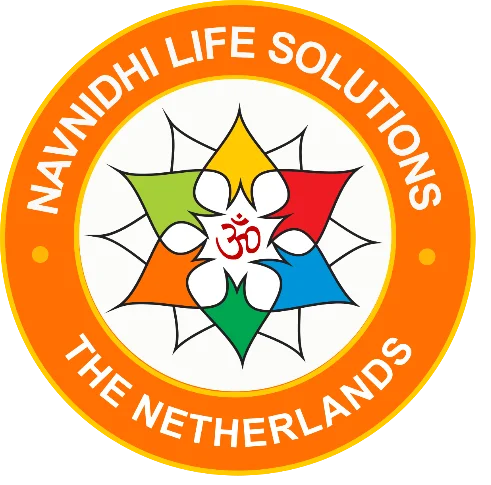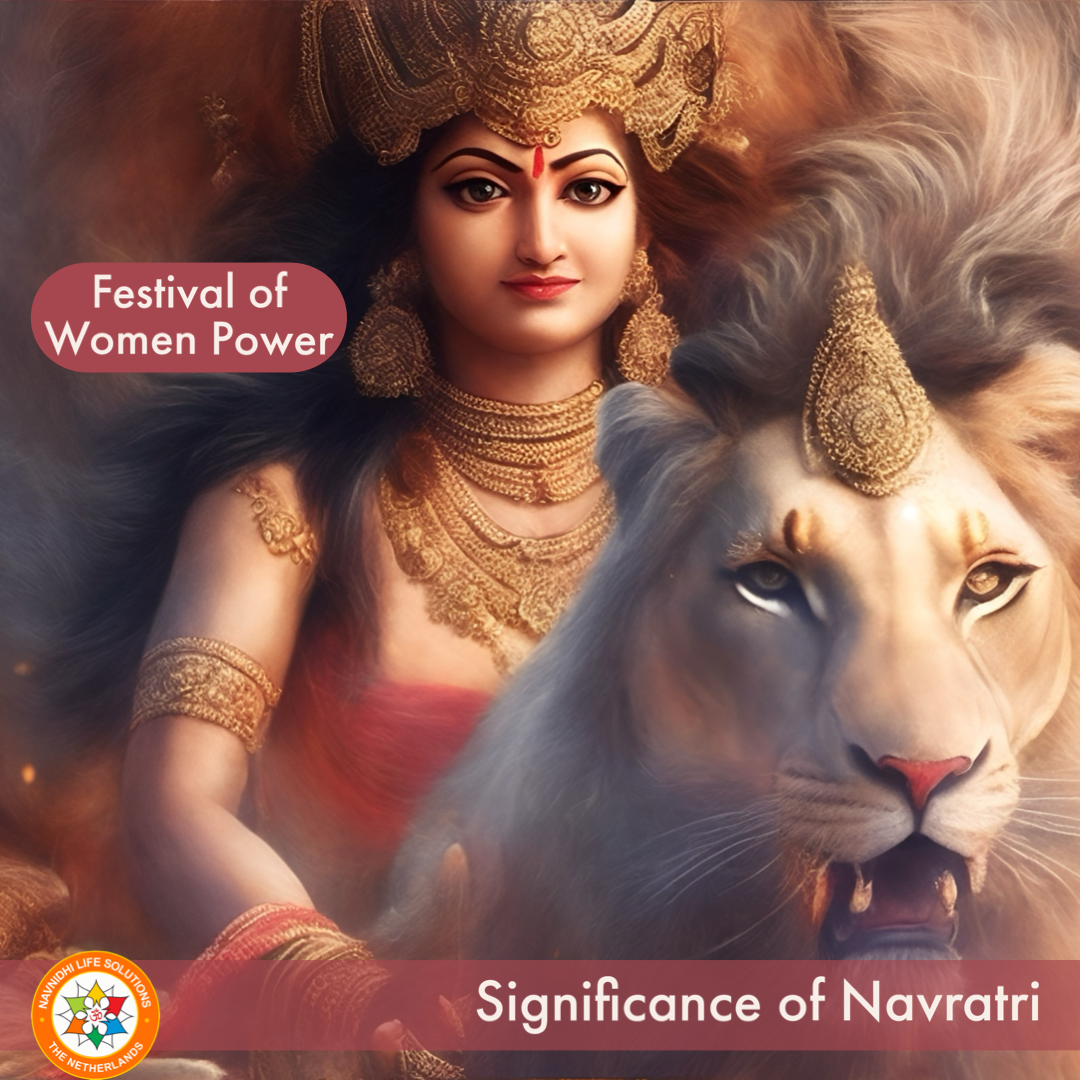Unconditional faith in Navratri 2024: victory of good over evil
Navratri is one of the grandest festivals in Hindu Culture, that is celebrated across not just India but the world. The nine days celebration finds its significant importance in the Hindu culture. Navratri has its origin from two Sanskrit words – ‘Nav’ meaning Nine and ‘Ratri’ meaning Night. These glorious nine nights and ten days are devoted to the worship of Devi Durga who represents the divine feminine energy also known as ‘Shakti’. Navratri exemplifies victory of good over evil, light over darkness and wisdom over ignorance. Across the world, devotees immerse in the celebration by fasting, praying and performing rituals. Let’s explore the significance of Navratri more as we delve deep into the world of celebration and spirituality.
Durga Puja in Navratri - Worshipping the Cosmic Feminine Energy
Throughout the nine days of Navratri, people devote themselves in the adoration of Devi Durga who is an embodiment to power and resilience. The celebration of Shakti is symbolic of the power that every woman has within themselves – the power to create and sustain life. Women is the source of energy & growth.
Significance of Navratri - The Victory of Good over Evil
Navratri is symbolic of the triumph of Devi Durga over the wicked demon named ‘Mahishasura’. According to the legend, Devi Durga was created by the energies of Lord Brahma, Lord Vishnu and Lord Shiva to slay Mahishasura whose unparalleled power was causing hindrance in the cosmos. After fighting for nine days, Devi Durga finally was able to vanquish Mahishasura on the tenth day. This episode is a reminder of the infinite power the Goddess holds. It inspires the devotees to consciously choose what is right and take a stand against any wrongdoings.
Navratri Celebration - across all Cultures
Navratri is celebrated across many states in India. Every state has its own rituals, customs and celebratory ceremonials that are observed during this time of the year. In Gujarat, devotees as a part of the Navratri ritual, indulge in hosting Garbas and Dandiya (different Navratri dance forms) events; where as in West Bengal it is celebrated as Durga Puja which is more than just a religious festival. That’s not all, people belonging to different social strata also participates in the celebration. Navratri hence is a celebration that fosters the essence of unity bringing together people to indulge in collective worship of the divine. It is one such festival that resonate inclusivity in Hindu festivals.
Navratri - the essence of Spiritual Renewal
Devotees are seen to engage in meditation, prayer, Navratri fasting practices and performing different ceremonial rituals throughout these nine days. They are seen to also perform our forms of spiritual practices that help in the process of seeking inner peace. Navaratri is symbolic of imbibing the positive spirit by discarding negativity.
Navaratri is a festival of love, light and spiritual purification. These glorious nine days constantly reminds us of the strength and power one has within oneself to overcome all the negativities. It encourages the devotees to embrace the essence of righteousness by practicing self-introspection through spirituality.
Navratri Legends
Nine Forms of Devi Durga
During the time of Navaratri, nine forms of Devi Durga or Navadurga are worshipped in all her glory. Here’s a guide to Navratri offering an explanation on the significance of Devi Durga and her nine forms:
Devi Shailaputri
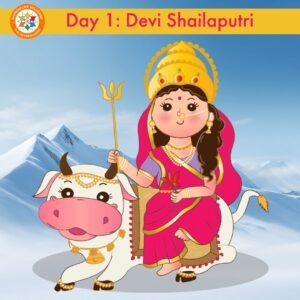
Goddess Shailaputri - first day of Navratri
Shailaputri is the daughter of the Mountain King Himalayas (‘Shail’ means ‘Mountain’ and ‘Putri’ means ‘daughter’). She is worshipped on the very first day of Navaratri as she is the first form of manifestation of Devi Durga. She is seen to ride a bull which is known as Nandi. Holding a Trishul (Trident) and a Lotus in both her hands, she embodies purity and strength.
In her previous birth, she was Devi ‘Sati’ – the daughter of Daksha, she offered herself in the Yagya Fire when Daksha insulted her husband Lord Shiva by not inviting him in the grand Yagya. King Himavan (or Himalaya) & his wife Devi Maina was doing severe penance of Devi Shakti seeking boon to get Devi Shakti herself as their daughter. Then, Devi was born as daughter of Himavan and got her name ‘Uma’, ‘Parvati’.
Devi BrahmaCharini
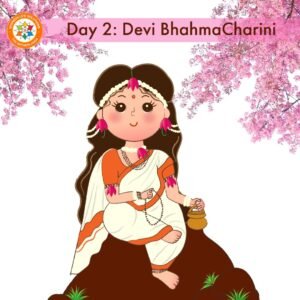
Goddess Brahmacharini - second day of Navratri
The second form of Durga is Goddess Brahmacharini is worshiped on the second day of Navaratri. She holds a Rudraksh mala and water pot (Kamandala) in her hands. Her feet remain bare as she represents the time when Goddess Parvati had immerse herself in deep meditation to please Lord Shiva. She signifies devotion, loyalty, and love. In this form, she is also known as TapaCharini. She bless devotees with knowledge & wisdom. ‘Brahma’ means ‘Tapa’ and ‘Charini’ means ‘Performer’.
According to legends, the great Sage Narada reminded her about her previous life as Sati Devi. As requested by King Himavant & Devi Maina, he did the palm reading of their beloved daughter Parvati. He informed that Lord Shiva would be her husband in this life and advised her to please Lord Shiva by meditating on him. When she started penance for Lord Shiva, she took the form of BrahmaCharini.
Devi Chandraghanta
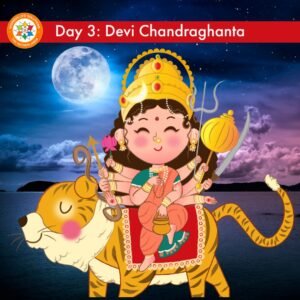
Goddess Chandraghanta - third day of Navratri
The third day of Navratri is dedicated to the worship of Devi Chandraghanta. Adorned by a bell shaped half-moon on her forehead, she rides a tiger. She is fierce and is an embodiment of grace and fearlessness. Riding a tiger gives golden hue to her skin that brightens the Universe. She possesses 10 hands, out of which eight hands are holding weapons and two hands are in blessing mudra. She has three eyes that makes her ultimate divine beauty. ‘Chandra’ means ‘ ‘moon’ & ‘Ghanta’ means ‘bell’. She blesses her devotees with courage, fearlessness & supreme bliss.
Devi Kushmanda
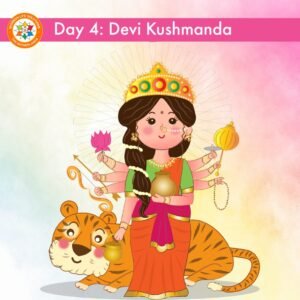
Goddess Kushmanda - fourth day of Navratri
On the fourth auspicious day of Navratri, Goddess Kushmanda is worshipped. According to the Navratri Mythology and legends, she is the creator of the universe. And her name is derived by amalgamating three words, ‘Ku’ (little), ‘Ushma’ (warmth or energy) and ‘Anda’ (egg) - that literally translates to ‘the one who has created the universe”. She blesses her devotees with energy & vitality.
She rides the lion & has 8 hands holding weapons, jar of elixir, and her one right hand is always in AbhayMudra (blessing). She created this Universe with her divine blissful smile. She is the energy giver to Lord Sun to make him capable of creating balance in maintain life in this Universe.
Devi Skandmata
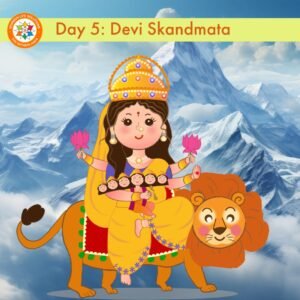
Goddess Skandmata - fifth day of Navaratri
She is worshipped on the fifth day of Navratri, and she is also referred to as Parvati, Maheshwari and Gauri. Holding little Karthik, she sits on lion, holding lotus in hands, this four armed deity symbolises knowledge and wisdom. ‘Skanda’ is the name of her elder son ‘Kartikeya’, ‘mata’ is mother, so Skandmata is the mother of Kartikeya – the chief commander of the army of Gods. Skandmata blesses the devotee with supreme ocean of knowledge.
With the grace of Devi SkandMata, the great legendry scholar Kalidas wrote two epic ‘Raghuvansha MahaKavya’ and ‘MeghDoot’.
Devi Katyayani
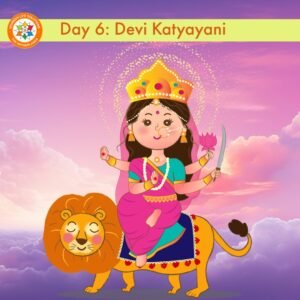
Goddess Katyayani - sixth day of Navaratri
She is worshipped on the sixth day of Navaratri, Goddess Katyayani is known for her fierceness and strength. Daughter of Sage Katyayan, She sits on a lion and is seen to hold a sword. She symbolises triumph over all things evil and negative.
Devi Katyayani has three eyes & four hands – one hand holds sword, two hands are in blessing posture, and one hand hold lotus.
Devi Kalratri
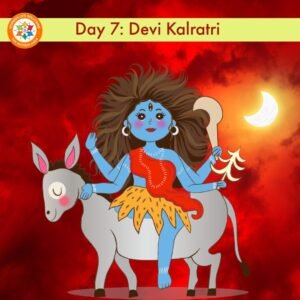
Goddess Kalratri - seventh day of Navratri
Goddess Kalratri is the seventh manifestation or form of Durga. As per the legends, in order to save the universe from the demons, she sacrificed her skin complexion by embracing darkness. She is known as the dark form of Durga and has a third eye on her forehead that holds the entire universe. It is believed that worship of Devi Kalratri can remove all the darkness from one’s life.
She has three round shaped bright eyes signifying universe. Her hairs are unlocked. She possesses four hands – two hands are holding weapons, one hand in blessing mudra and one hand is in fearless style. She blesses her devotees with fearlessness. She ride on the faithful donkey. She is also known as ‘Shubhamkari’, because she blesses her devotees with prosperity and auspiciousness.
Devi MahaGauri
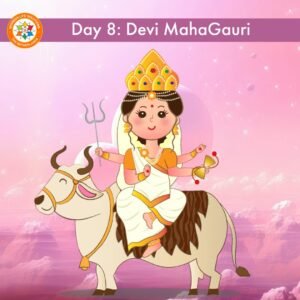
Goddess Mahagauri - eigth day of Navaratri
‘Maha’ means ‘great’ and ‘Gauri’ means ‘White brightening’. She blesses her devotees with enlightenment and removes the fear of death.
On the eighth day, Devi Mahagauri is worshipped. She is known for her moon like bright skin. She wears white clothing and rides bull. She is an embodiment of peace and serenity. He divine aura radiates positivity. She has three eyes & four hands – one hand is in blessing gesture, one hand is in Fear repelling gesture, one hand holds drum and other hand holds a trident.
Devi Siddhidatri

Goddess Siddhidatri - ninth day of Navaratri
On the ninth and the final day of Navratri, Goddess Siddhidatri is worshipped. She is a four armed deity holding a mace, discus, a book, and lotus in her hands. She has eight supernatural powers, which is also known as ‘siddhis’. These are Anima, Mahima, Garima, Laghima, Prapti, Prakambya, Ishitva and Vashitva. She represents prosperity and fulfilment. She is always anxious to help her devotees, blesses with knowledge to bring purity in life.
Which Navratri Mantra is best to do?
Amongst various mantras, hymns, and worship procedures, everyone should read the following hymns and mantras during Navratri to seek blessings of Goddess Durga:
- Shri Durga Kavach
- Shri Argala Stotra
- Shri Keelak Stotra
- MahishasurMardini Stotr
- Beej Mantra – Om Aing Hreeng Kleeng Chaamundaay Vicchay
Worship Anushthaan during Navratri
Navratri is the best time to achieve impossible tasks as these are the 9 divine days and nights during Goddess Durga blesses the devotees with all the desires fulfilled. It’s best to take learned priests help to perform
- Navratri Anusthaan
- ShatChandi Yagya
- NavChandi Yagya
- Sahastra Chandi Yagya
Conclusion
Navratri constantly reminds us of the existence of the divine feminine power or energy that holds the universe together. Through these nine days of celebration, devotees pray to the goddess and seek her blessings for protection, good fortune and overall spiritual well-being. May we be filled with Goddess’s strength to overcome all the difficulties and walk on the path of enlightenment and positivity. Goddess Durga is ultimately pleased with your devotion, dedication, & your righteousness.

